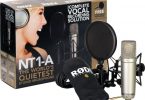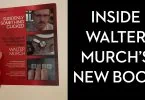Sound Design Tips for Film Editors
Sound design is a hugely important topic for any editor to increase their knowledge of. There’s a whole category on the blog devoted to sound design, but I’ve not written a specific focused post on it in quite some time!
That said, a few related recent sound related highlights include, selecting the best Studio Monitors, the best sites for production music, sound design and editing tutorials and plenty of making of’s including The Revenant, Deadpool, The Martian and more!
In this post I thought I’d bring together the best resources and tutorials I’ve seen lately on sound design, editing and mixing. But first a little inspiration….
https://vimeo.com/170948796
In this beautifully produced short of the week, you can get a graceful introduction to The Secret World of Foley. A relaxing and entertaining watch!
Inspiring Sound Design
Sound design supremo Ben Burtt, who is also featured in these previous posts on Sound Design, demonstrates how things used to be done with an eight-track recorder as he pulls together the sound design element for the Millennium Falcon’s hyperdrive failing in The Empire Strikes Back.
In this short video from Wired you can see what it takes to create a little bit of foley sound design for a short scene from Zootopia with help from the team at Skywalker Sound’s new facility.
In this short clip from a Sight Sound and Story seminar you can hear from the audio post-production team on Life of Pi, as they discuss the process of designing and mixing a scene.
Sound Design and Editing Tutorials
In this ten minute tutorial from The Editor’s Lounge, highly experienced audio mixer Erik Valenzuela and Curtis Fritsch talk through how best to prepare for an audio mix as an editor.
Topics include creating all the deliverables you need to turn over including correctly set up quicktime reference files, aaf and omf outputs, how to cut and mix dialogue, effects and music and a whole bunch more!
In this 20 minute demonstration from Jason Levine you can get a good preview of the audio features coming in to Adobe Audition, which will be a real boost to editor looking to improve their audio post abilities without a lot of effort.
Update – This feature update to the Adobe Creative Cloud is now available to download!
Sound designer and mixer Michael Cardillo is filling a niche and providing some excellent sound editing and mixing tutorials aimed at editors on his site.
I’ve previously included many of his audio tutorials, aimed at Premiere Pro editors in this round up of tips and tutorials, but there’s a wealth of great info on audio in that post so do check it out!
While you may be tempted to leave your VO seemless like dialog, you may find that it actually sounds better to trim every region to only what is needed. Not only does this aid in the elimination of mouth noise and breaths, but it causes you to focus your attention to every detail of the voice-over performance and you’re more likely to slide phrases around and put the pauses where they can better help tell the story.
In this short post on the difference between editing voice over and dialogue, Michael shares a few pearls of wisdom on how to best approach editing each type of sound and why you might want to take a different tach with each.
Over on Linked In (do people use that?) Michael provides some helpful and quick answers to three quick questions on audio levels:
Q1: While I’m editing, should I normalize each clip to -6 (or 0 or -12)?
Q2: What should be my target level on the first pass?
Q3: How about the final pass?

In this excerpt from Dialogue Editing for Motion Pictures: A Guide to the Invisible Art by John Purcell, you can learn how to help out your fellow sound editors and create better sounding dialogue in your own cuts.
If a vowel is terminated with a sharp consonant sound, you might be able to shorten the end of the vowel using the attacking consonant sound to mask the vowel glitch. Try it; it just might work.
Woody Woodhall is an award winning supervising sound editor, sound designer and rerecording mixer who blogs over on ProVideoCoalition. In this detailed post he walks through the concepts and process of creating and delivering split-tracks, or audio stems in post production.
Stem outputs, also interchangeably called split tracks or just stems, are a separation of the final mix into discrete audio elements. Generally, a full mix is stemmed or split out into various combinations of the dialog, music and effects (DME) elements from the full mix.
Woody provides plenty of fine-grain explanation as well as a tour of some of the common challenges to doing this effectively.
As a quick aside, even if you’re handling your project’s entire post-production yourself (editing, mixing, grading and delivery) and not sending anything on to a professional sound mixer, it’s always worth exporting split-track audio stems along with your final picture as part of your mastering and archive process.
This is because it makes it possible to do quick client re-edits later on down the line, because you can work with all of your audio elements as separate pieces and so you can remove your music – which might be running through much of your project, and cut it down. All of your audio isn’t all baked together into a stereo mix down.
In this second detailed post Woody provides a solid foundation to understanding EQ and the various EQ filters you’re likely to find in your NLE’s audio effects toolkit. If you’re an editor who doesn’t quite know what they’re doing when it comes to the various options available to you when adjusting your audio’s EQ then this post will help you get a foothold and provide some great tips.
The idea with EQ is generally to do as little as possible to affect the desired change. Improperly applied EQ can easily mangle the recorded audio to something unacceptable.
Production Sound Tutorials for Beginners
In this entertaining 20 minute guide to the basics of production sound, and the main problems new filmmakers face when recording decent sound, you can get a very fast lesson in all the essentials. If only everyone actually did most of these simple things. Check out more from Basic Filmmaker here.
https://vimeo.com/78168867
In this tutorial from LightsFilmSchool you can get a strong introduction to the fundamentals of how sound moves through the production and post-production process and a good understanding of each of the roles involved from the boom operator, to the dialogue editor, foley artists and re-recording mixer.
You can get more free tutorials from Lightsfilmschool here, that are pitched at a similar level of experience and understanding.








